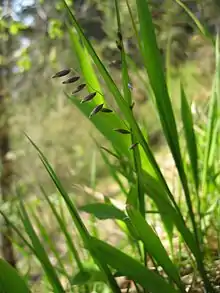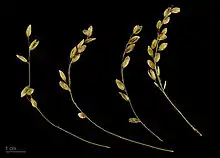Melica nutans
Melica nutans, known as mountain melick,[1] is a grass species in the family Poaceae, native to European, Eurasian, and Asian forests.[2]
| Melica nutans | |
|---|---|
 | |
| Scientific classification | |
| Kingdom: | Plantae |
| Clade: | Tracheophytes |
| Clade: | Angiosperms |
| Clade: | Monocots |
| Clade: | Commelinids |
| Order: | Poales |
| Family: | Poaceae |
| Subfamily: | Pooideae |
| Genus: | Melica |
| Species: | M. nutans |
| Binomial name | |
| Melica nutans | |

Description
The grass has slender creeping rhizomes. The culms are 25–970 centimetres (9.8–381.9 in) tall.[2] It inflorescence is comprised out of 5–15 fertile spikelets, which are both oblong and compressed, with the length of 6–8 millimetres (0.24–0.31 in). They are comprise out of 2-3 fertile florets that are diminished at the apex. The florets are 5–7 millimetres (0.20–0.28 in) long and are elliptic. Flowers have 3 anthers which are 1.5–2 millimetres (0.059–0.079 in) in length. Glumes are thinner than fertile lemma with the lower one being of 4–6 millimetres (0.16–0.24 in) which is one length of upper one.[3]
Habitat
It is found at 1,500–2,300 metres (4,900–7,500 ft) of elevation, in shady and hillside habitats.[2]
References
- "BSBI List 2007". Botanical Society of Britain and Ireland. Archived from the original (xls) on 2015-01-25. Retrieved 2014-10-17.
- "Melica nutans". Flora of China. Retrieved July 7, 2012.
- W.D. Clayton; M. Vorontsova; K.T. Harman; H. Williamson. "Melica nutans". The Board of Trustees, Royal Botanic Gardens. Kew: GrassBase.